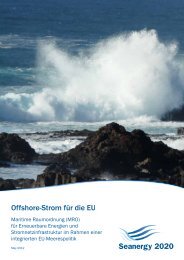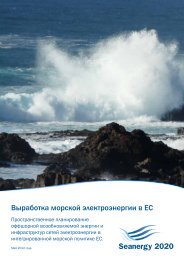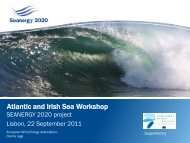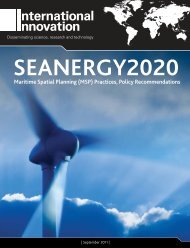Comparative analysis of Maritime Spatial Planning ... - Seanergy 2020
Comparative analysis of Maritime Spatial Planning ... - Seanergy 2020
Comparative analysis of Maritime Spatial Planning ... - Seanergy 2020
You also want an ePaper? Increase the reach of your titles
YUMPU automatically turns print PDFs into web optimized ePapers that Google loves.
eing responsible for the EEZ outside the Territorial Sea. Nevertheless for a wind farm to be built in the EEZwould still involve the Landers in cable and grid connection documentation. To limit wind farms mostly tothe EEZ, that is beyond the 12nm zone as is the case for Germany, would not necessarily be best practicefrom the sector point <strong>of</strong> view but in the case <strong>of</strong> Germany the limitation is specifically linked to theenvironmentally protected status <strong>of</strong> the Waddensea. This does highlight the role <strong>of</strong> MSP since it enablesthe state to give clear indications as to its priorities, in this case environmental protection.The Mediterranean countries, Italy and Greece, gave no detail on EEZ process since at the moment they donot claim EEZs. Their process refers entirely to the Territorial Sea therefore. As such, Greece requiresseveral permits but only through two authorities whereas Italy has one unified process which is required togo through several authorities. It is also significant that, in Italy, regional authorities are also reported toplay a part. The difficult position <strong>of</strong> Mediterranean countries which plan wind farms outside the TerritorialSeas is highlighted above. For whilst a country may have the right to put a structure on the sea bed <strong>of</strong> thecontinental shelf and lay cables there is still the necessity <strong>of</strong> integrating the infrastructure with othereconomic activities such as navigation, fishing or other energy sectors in areas outside national planningjurisdiction.Technically the UK has also not claimed an EEZ , but in fact, its Territorial Sea and a Fisheries ProtectionZone which covers the area <strong>of</strong> sea which would equate to the EEZ if it were claimed. This, however, has nojurisdiction for wind power except in as much as it interferes with fishing. It does, however, haveconsiderable implications for the general commitment to MSP, including wind power, as discussed abovein relation to overall policy commitment.4.1.4 Offshore Wave and Tidal PowerThere may be fewer opportunities to develop tidal power in some sea-basins since tidal range is very smallthroughout the Mediterranean basin and also in much <strong>of</strong> the Baltic Sea basin.In addition, details on permitting requirements generally are very sparse because power generation fromthese sources has not yet progressed very far. A possible exception is France which has the tidal powerstation at La Rance in Brittany which has been operating since 1966 with an output <strong>of</strong> 240MW 17 .Nevertheless no permitting arrangements were recorded for France. Eight countries seem to have targetsfor <strong>2020</strong>: Finland, France, Ireland, Italy, Portugal, Spain and the United Kingdom 18 . There are reported tobe demonstration plants in Denmark, Scotland, Sweden and Portugal and, just recently in 2010, theScottish Government has issued leases in respect <strong>of</strong> 1.2GW for projects in the Pentland Firth,demonstrating a clear political will and plans to develop wave and tidal energy.17 Source: The European Ocean Energy Association (EU-OEA), February 201118 National Action Plans for the promotion and use <strong>of</strong> renewable energy (NREAPs), available athttp://ec.europa.eu/energy/renewables/transparency_platform/action_plan_en.htm#Deliverable 2.325 | P a g e






